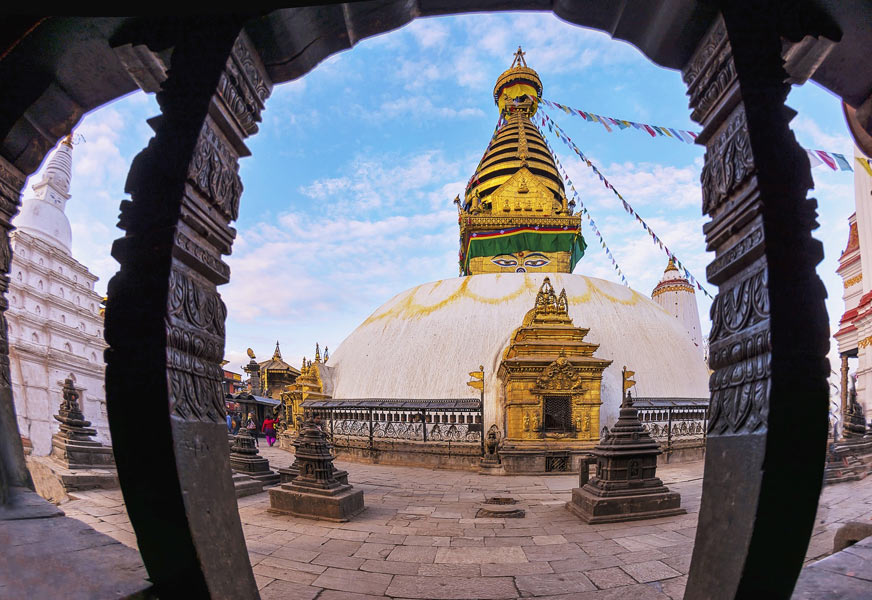Nepal Tour Guide’s Kathmandu Valley Tour takes you to the prehistoric sites in three districts, namely Kathmandu, Bhaktapur and Lalitpur. This tour not only showcases the rich culture of the Nepalese people but also takes you back in time through it’s architectural and cultural wonders. It is because of this reason that Kathmandu, Lalitpur and Bhatapur are declared as UNESCO World Heritage Sites.
On the first day, you will visit four places in Kathmandu namely Kathmandu Durbar Square, Pashupatinath, Boudhanath and Swayambhunath temples. These sites hold tremendous religious and cultural importance to the Nepalese people and showcase Nepalese art and architecture at its best. The Durbar Squares are social and cultural focal point of the city and all the major social ceremonies are performed here. The architecture in the squares is typical of the Malla Dynasty that ruled over Kathmandu districts from the 12th to the 18th century.
Swayambhunath Stupa aka Monkey Temple
You also visit the Swayambhunath Temple on this day. The temple is lovingly known as the Monkey Temples by foreign travellers because of the large monkey population living in the area. The temple rests atop a hill and legend has it that, about 2,000 years ago, the temple rose out of a lotus flower blooming in the middle of a primordial lake that once spread across the entire Kathmandu valley. The Swayambhunath temple has an intriguing mix of both Hindu and Buddhist shrines. And its majestic white dome and glittering golden spire is visible from miles around the valley.
Pashupatinath Temple
Another World Heritage site of tremendous importance, not just for the Nepalese but also for the Hindus worldwide, is the Pashupatinath Temple. This is one of the main temples of Lord Shiva. Hindu cremation ceremonies take place here on a large scale. Foreigners may find these sites alien but it is hard not to get a profound sense of life and death watching an amalgamation of death ceremonies, devotional songs, rituals and festivities all happening at the same place at the same time. Since the main Lord Shiva temple is very sacred, only Hindus are allowed to enter the vicinity, but foreigners can respectfully observe all the proceedings from the opposite side of the river banks.
Boudhanath Stupa
The Boudhanath Temple or Stupa is one of the largest you will find in South Asia. It was built on an ancient trade route to Tibet by Tibetan merchants and even to this day, sees large inflow of Tibetan refugees. There are numerous tibetan monasteries built around the area, the main stupa on the other hand, is built in a Nepali Buddhist style architecture, similar to that of the Monkey Temple. Here in Bouddha, the town named after the stupa, one gets to experience an amalgamation of both Nepali and Tibetan art and culture.
Patan Durbar Square
Nepal Tour Guide’s second day takes you to the durbar squares of Patan and Bhaktapur. Patan Durbar Square that lies to the south-east of Kathmandu is considered to be the oldest among the three cities of the valley. Patan, or it’s older more traditional name Lalitpur is the ‘City of Arts’. The reason behind the name will be apparent once you visit this thriving city. The Patan Durbar Square has many historic temples and buildings from Krishna Mandir to Bhimsen Temple, to Taleju Bhawani Temple to the Golden Temple (Rat Temple), located just north of the square.
Bhaktapur Durbar Square
You then head about 13km east to Bhaktapur Durbar Square. Bhaktapur means the ‘City of Devotees’ and you can experience festivals and ceremonies here that are not found anywhere else in Nepal. During city sightseeing in Bhaktapur Durbar Square, you can experience the collection of pagoda style temples, the 55-window palace of brick and wood being the one of the more famous one.The city has one of the best preserved cultures dating back even to the 8th century A.D. Sites like Taumadhi square, Dattatreya square, National Art Museum, and Nyatapole Temple, among others, sets it apart from Patan and Kathmandu Durbar Squares.
The 2015 mega-earthquake that hit Nepal saw the loss of the majority of the ancient and cultural treasures in Bhaktapur but the locals residents have residents have remained resilient and have even set an example to rebuild the national heritage through a community-led rebuilding initiative. This private tour guide will take you along an intimate, time travelling experience where you soak in every stories and legends behind the ancient valley.


